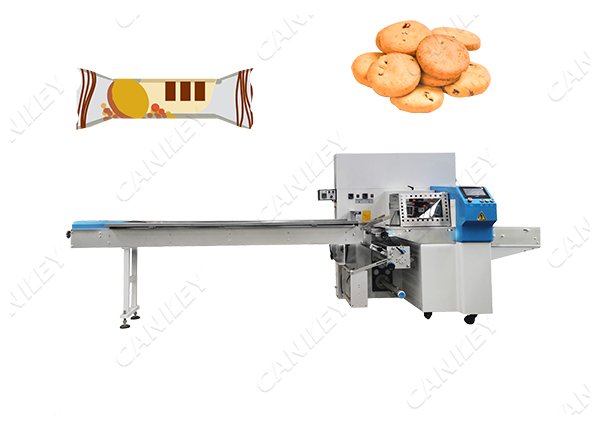How Are Biscuits Packed In A Factory Explain?
- Release Lime: Mar 13 2024
- Source: Sherry
In the fast-paced world of food production, efficiency and precision are paramount. Nowhere is this more evident than in the packaging process of beloved snacks like biscuits. With the advancement of technology, biscuit packaging has evolved from manual labor to a highly automated and streamlined operation. Let's take a closer look at how are biscuits packed in a factory explain through an automatic biscuit packaging line.

Initial preparation: Before the biscuits even reach the packaging line, they undergo thorough quality control checks to ensure they meet the company's standards. Any damaged or defective biscuits are removed from the production line to maintain the quality of the final product.
Feeding stage: The biscuits are then fed into the automatic packaging line. This can be done through a variety of methods depending on the specific setup of the factory. In some cases, biscuits are transported via conveyor belts, while in others, robotic arms may be utilized for precise handling.
Sorting and orientation: Once the biscuits enter the packaging line, they are sorted and oriented correctly. This step is crucial to ensure that each package contains biscuits positioned uniformly, enhancing the overall presentation and appeal of the product.
Packaging material selection: The appropriate packaging material is selected based on factors such as the type of biscuits being packaged, shelf life requirements, and branding considerations. Common materials include plastic wrappers, foil pouches, or cardboard boxes.
Forming and sealing: Next, the packaging material is formed around the biscuits and sealed to create individual packages. This process is typically automated using machinery equipped with precision controls to ensure consistent sealing and airtight packaging.
Labeling and coding: As the packaged biscuits move along the production line, labels containing important information such as nutritional content, expiration dates, and barcode data are applied. Additionally, coding systems may be used to imprint batch numbers or production dates for traceability purposes.
Quality inspection: Throughout the packaging process, automated quality control systems are in place to detect any irregularities or defects in the packaging. This may include checks for proper sealing, accurate labeling, and the presence of foreign objects.
Secondary packaging: Once the individual biscuit packages are complete, they may be further packaged into larger containers or boxes for transportation and distribution. Again, this step is often automated to optimize efficiency and minimize human error.
Final inspection and packing: Before the packaged biscuits are ready for shipment, a final inspection ensures that they meet the company's quality standards. Any packages that do not meet the criteria are removed from the production line. Finally, the packaged biscuits are packed into shipping crates or pallets, ready to be sent to retailers or distributors.
In conclusion, the automatic biscuit packaging line exemplifies the marriage of technology and food production, allowing for efficient, consistent, and high-quality packaging of biscuits on a large scale. By leveraging automation and advanced machinery, manufacturers can meet the demands of consumers while maintaining the integrity and freshness of their products.

Initial preparation: Before the biscuits even reach the packaging line, they undergo thorough quality control checks to ensure they meet the company's standards. Any damaged or defective biscuits are removed from the production line to maintain the quality of the final product.
Feeding stage: The biscuits are then fed into the automatic packaging line. This can be done through a variety of methods depending on the specific setup of the factory. In some cases, biscuits are transported via conveyor belts, while in others, robotic arms may be utilized for precise handling.
Sorting and orientation: Once the biscuits enter the packaging line, they are sorted and oriented correctly. This step is crucial to ensure that each package contains biscuits positioned uniformly, enhancing the overall presentation and appeal of the product.
Packaging material selection: The appropriate packaging material is selected based on factors such as the type of biscuits being packaged, shelf life requirements, and branding considerations. Common materials include plastic wrappers, foil pouches, or cardboard boxes.
Forming and sealing: Next, the packaging material is formed around the biscuits and sealed to create individual packages. This process is typically automated using machinery equipped with precision controls to ensure consistent sealing and airtight packaging.
Labeling and coding: As the packaged biscuits move along the production line, labels containing important information such as nutritional content, expiration dates, and barcode data are applied. Additionally, coding systems may be used to imprint batch numbers or production dates for traceability purposes.
Quality inspection: Throughout the packaging process, automated quality control systems are in place to detect any irregularities or defects in the packaging. This may include checks for proper sealing, accurate labeling, and the presence of foreign objects.
Secondary packaging: Once the individual biscuit packages are complete, they may be further packaged into larger containers or boxes for transportation and distribution. Again, this step is often automated to optimize efficiency and minimize human error.
Final inspection and packing: Before the packaged biscuits are ready for shipment, a final inspection ensures that they meet the company's quality standards. Any packages that do not meet the criteria are removed from the production line. Finally, the packaged biscuits are packed into shipping crates or pallets, ready to be sent to retailers or distributors.
In conclusion, the automatic biscuit packaging line exemplifies the marriage of technology and food production, allowing for efficient, consistent, and high-quality packaging of biscuits on a large scale. By leveraging automation and advanced machinery, manufacturers can meet the demands of consumers while maintaining the integrity and freshness of their products.

 0086-15515573212
0086-15515573212 info@cankeytech.com
info@cankeytech.com



 Your Location:
Your Location: